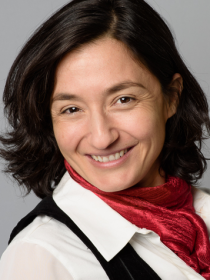Related Research Articles

Photovoltaics (PV) is the conversion of light into electricity using semiconducting materials that exhibit the photovoltaic effect, a phenomenon studied in physics, photochemistry, and electrochemistry. The photovoltaic effect is commercially used for electricity generation and as photosensors.
In the 19th century, it was observed that the sunlight striking certain materials generates detectable electric current – the photoelectric effect. This discovery laid the foundation for solar cells. Solar cells have gone on to be used in many applications. They have historically been used in situations where electrical power from the grid was unavailable.

A solar cell, or photovoltaic cell, is an electronic device that converts the energy of light directly into electricity by the photovoltaic effect, which is a physical and chemical phenomenon. It is a form of photoelectric cell, defined as a device whose electrical characteristics, such as current, voltage, or resistance, vary when exposed to light. Individual solar cell devices are often the electrical building blocks of photovoltaic modules, known colloquially as solar panels. The common single junction silicon solar cell can produce a maximum open-circuit voltage of approximately 0.5 to 0.6 volts.
The UNSW Solar Racing Team is the solar car racing team of the University of New South Wales in Sydney, Australia. The team currently holds a number of world records and is best known for its participation in the World Solar Challenge (WSC). Since its founding in 1996 by Byron Kennedy, the Sunswift team has built a total of 6 different cars, the most recent of which is Sunswift VI.

Martin Andrew Green is an Australian engineer and professor at the University of New South Wales who works on solar energy. He was awarded the 2021 Japan Prize for his achievements in the "Development of High-Efficiency Silicon Photovoltaic Devices". He is editor-in-chief of the academic journal Progress in Photovoltaics.
Third-generation photovoltaic cells are solar cells that are potentially able to overcome the Shockley–Queisser limit of 31–41% power efficiency for single bandgap solar cells. This includes a range of alternatives to cells made of semiconducting p-n junctions and thin film cells. Common third-generation systems include multi-layer ("tandem") cells made of amorphous silicon or gallium arsenide, while more theoretical developments include frequency conversion,, hot-carrier effects and other multiple-carrier ejection techniques.

Solar power is the conversion of energy from sunlight into electricity, either directly using photovoltaics (PV) or indirectly using concentrated solar power. Photovoltaic cells convert light into an electric current using the photovoltaic effect. Concentrated solar power systems use lenses or mirrors and solar tracking systems to focus a large area of sunlight to a hot spot, often to drive a steam turbine.
The Faculty of Engineering is a constituent body of the University of New South Wales (UNSW), Australia. UNSW was formed on 1 July 1949, and the Faculty was established on 8 May 1950 with the inaugural meeting of the Faculty taking place on 7 June 1950. It was one of the first three University faculties which were established by Council, and was initially formed of four departments including Electrical Engineering, Mechanical Engineering, Civil Engineering and Mining Engineering, headed by Dean Professor Harold Brown.
GreatCell Solar Limited previously known as Dyesol, was a solar energy company developing perovskite solar cell 3rd generation thin-film solar cell technologies and materials. The company was previously focused on developing dye-sensitized solar cell technology but then focused on perovskite solar cells, and assisted manufacturing partners to produce perovskite photovoltaic modules. The company was based in Queanbeyan, Australia and opened its manufacturing and research facilities in October 2008. It expanded to several locations around the world, including the UK and Switzerland, and established joint ventures in South Korea and Singapore.
Stuart Wenham was, at the time of his death, the director of the ARC Centre of Excellence in Advanced Silicon Photovoltaics and Photonics and Director of Academic Studies of the School of Photovoltaic and Renewable Energy Engineering at the University of New South Wales.

A thin-film solar cell is a second generation solar cell that is made by depositing one or more thin layers, or thin film (TF) of photovoltaic material on a substrate, such as glass, plastic or metal. Thin-film solar cells are commercially used in several technologies, including cadmium telluride (CdTe), copper indium gallium diselenide (CIGS), and amorphous thin-film silicon.
Yang Yang is a Taiwanese-American materials scientist. He is a Professor of Materials Science and Engineering, and Professor of Bioengineering at the University of California, Los Angeles, where he holds the Carol and Lawrence E. Tannas Jr. Endowed Chair in Engineering. Yang is known for his contributions to polymer organic solar cells and lead-halide perovskite solar cells. He was named as one of the "World’s Most Influential Scientific Minds" by Thomson Reuters in 2016. Yang is a fellow of the American Association for the Advancement of Science, American Physical Society, Materials Research Society, Royal Society of Chemistry, and Society of Photo-Optical Instrumentation Engineers.

A perovskite solar cell (PSC) is a type of solar cell that includes a perovskite-structured compound, most commonly a hybrid organic–inorganic lead or tin halide-based material as the light-harvesting active layer. Perovskite materials, such as methylammonium lead halides and all-inorganic caesium lead halide, are cheap to produce and simple to manufacture.

Henry James Snaith is a professor in physics in the Clarendon Laboratory at the University of Oxford. Research from his group has led to the creation of a new research field, based on halide perovskites for use as solar absorbers. Many individuals who were PhD students and postdoctoral researchers in Snaith's group have now established research groups, independent research portfolios and commercial enterprises. He co-founded Oxford Photovoltaics in 2010 to commercialise perovskite based tandem solar cells.
Tsutomu Miyasaka, is a Japanese engineer in electrochemistry best known for the inventor of perovskite solar cell.
Oxford Photovoltaics Limited is an Oxford University spin-off company in the field of perovskite photovoltaics and solar cells.

Mohammad Khaja Nazeeruddin is an Indian-Swiss chemist and materials scientist specialized in Perovskite solar cells, dye-sensitized solar cells, and light-emitting diodes. He is a professor at EPFL and the director of the Laboratory for Molecular Engineering of Functional Materials at School of Basic Sciences.
Giulia Grancini is an Italian physicist who is a Professor of Chemistry at the University of Pavia. Her work considers new materials for photovoltaic devices, including perovskites and polymer-based materials. In 2020, Grancini was named the Royal Society of Chemistry Journal of Materials Chemistry Lecturer.

Maria Antonietta Loi is an Italian physicist who is a Professor of Optoelectronics at the University of Groningen and member of the Zernike Institute for Advanced Materials. Her research considers the development of functional materials for low-cost, high efficiency photovoltaics. She was awarded the 2018 Netherlands Physical Society Physics prize (Physicaprijs). In 2020, she was elected Fellow of the American Physical Society. Loi is Deputy Editor of Applied Physics Letters.

Emily Warren is an American physicist who is a staff scientist at the National Renewable Energy Laboratory. Her research considers high efficiency crystalline photovoltaics.
References
- 1 2 "Associate Professor Anita Wing Yi Ho-Baillie". research.unsw.edu.au. Retrieved 22 June 2021.
- ↑ Ho, Anita Wing Yi (2004). A novel rear contacting tecnique for buried contact solar cells (Thesis). OCLC 225604735.
- 1 2 Anonymous (4 November 2008). "Magic solar milestone reached". UNSW Newsroom. Retrieved 22 June 2021.
- ↑ z3509982 (2 December 2016). "Trendy solar cells hit new world efficiency record". UNSW Newsroom. Retrieved 22 June 2021.
- ↑ "'Solar cells are no longer limited to rigid structures such as panels'". NewsComAu. 22 March 2017. Retrieved 22 June 2021.
- 1 2 "Subscribe to The Australian | Newspaper home delivery, website, iPad, iPhone & Android apps" . Retrieved 22 June 2021.
- ↑ "Anita Ho-Baillie announced as inaugural John Hooke Chair of Nanoscience". www.myscience.org. 29 May 2020. Retrieved 22 June 2021.
- ↑ Jewell, Cameron (7 June 2017). "The holy grail of glazing: high-insulating, energy-generating glass on the way". The Fifth Estate. Retrieved 22 June 2021.
- ↑ Hannam, Peter (21 May 2020). "Australian scientists 'drastically improve' new solar cell technology". The Sydney Morning Herald. Retrieved 22 June 2021.
- ↑ "Sydney Nano wins $2.5m federal funding for solar energy research". The University of Sydney. Retrieved 22 June 2021.
- ↑ AnitaABCWeekendMorning , retrieved 22 June 2021
- ↑ ABCRN , retrieved 22 June 2021
- ↑ "Next-generation solar cells pass strict international tests". The University of Sydney. Retrieved 22 June 2021.
- ↑ "Australian researchers claim world first in global race to develop better solar panels". the Guardian. 21 May 2020. Retrieved 22 June 2021.
- ↑ Hu, Long; Zhao, Qian; Huang, Shujuan; Zheng, Jianghui; Guan, Xinwei; Patterson, Robert; Kim, Jiyun; Shi, Lei; Lin, Chun-Ho; Lei, Qi; Chu, Dewei (20 January 2021). "Flexible and efficient perovskite quantum dot solar cells via hybrid interfacial architecture". Nature Communications. 12 (1): 466. Bibcode:2021NatCo..12..466H. doi:10.1038/s41467-020-20749-1. ISSN 2041-1723. PMC 7817685 . PMID 33473106. S2CID 221712245.
- ↑ z3525214 (20 November 2019). "UNSW academics abound on list of world's most influential researchers". UNSW Newsroom. Retrieved 22 June 2021.
- ↑ "Highly Cited Researchers". publons.com. Retrieved 22 June 2021.
- ↑ "Sydney has the most influential academics in Australia". The University of Sydney. Retrieved 22 June 2021.
- ↑ "2021 Eureka Prize finalists announced". The University of Sydney. 2 September 2021. Retrieved 1 November 2021.
- ↑ "Nine Sydney researchers awarded ARC Future Fellowships". The University of Sydney. 11 August 2021. Retrieved 1 November 2021.
- 1 2 "Ho-Baillie, Anita". Web of Science. Retrieved 16 November 2022.
- ↑ "Three scientists win Royal Society of NSW awards". The University of Sydney. Retrieved 8 December 2022.